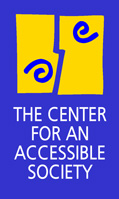
DISABILITY
ISSUES
INFORMATION
FOR
JOURNALISTS
ABOUT
THE CENTER
The next brainiacs
Note to readers: links to news articles may not work after a few weeks, as news media remove current stories to their archives. The link may take you to the archives section, where, for a fee, you can view the article.
Aug. 28, 2001 -- "We live at a time when the disabled are on the leading edge of a broader societal trend toward the use of assistive technology," writes John Hockenberry in this month's issue of Wired magazine (online at http://www.wired.com/wired/archive/9.08/assist_pr.html
"Bodies are perhaps a somewhat arbitrary evolutionary solution to issues of mobility and communication," he explains, echoing the sentiments of Berkeley's Michael Williams, a user and longtime proponent of "augmented communication." "By this argument, the brain has no particular preference for any physical configuration as long as functionality can be preserved."
"The greatest thing people with disabilities have done for the general population is to make it safe to look weird," says Williams. "It's certainly true that the general population has glommed onto some principles of assistive tech. Just roll down the street and observe the folks with wires dangling from their ears. Look at the TV commercials featuring guys with computerized eyewear."
Writing of the "universal redrafting of the human design specification," Hockenberry says that "in a straightforward way that needs no psychological jargon to explain, my former body simply doesn't exist anymore. Like Isaac Stern and his violin, I am now part chair, with some capabilities that exceed my original specifications."
Read Hockenberry's entire article, "The Next Brainiacs," online at http://www.wired.com/wired/archive/9.08/assist_pr.html
One of the places mentioned in Hockenberry's story, the Cleveland FES Center, a consortium of the Cleveland VA Medical Center, Case Western Reserve University, the MetroHealth Medical Center and the Edison BioTechnology Center, is at http://feswww.fes.cwru.edu/
The National Institute on Disability and Rehabilitation Research funds projects in assistive technology. "NIDRR's research priorities in engineering and technology will help improve functional outcomes and access to systems technology in sensory function, mobility, manipulation, cognitive function, information communication, and the built environment," says its Long-Range Plan; read more at http://www.ncddr.org/rpp/techaf/lrp_ov.html -- and for an overview of NIDRR projects in this area, go to http://www.accessiblesociety.org/topics/technology/index.htm -- or visit the National Center for the Dissemination of Disability Research's webpage on "Technology for Access and Function Research" at http://www.ncddr.org/rpp/techaf/index.html